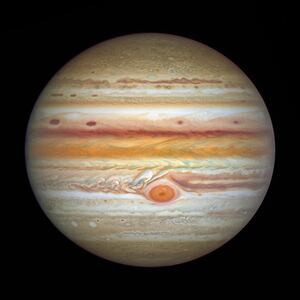Ask any astronaut or astronomer and they’ll tell you: Space wants to kill us. It doesn’t matter if we’re talking about the extreme life-threatening cold and hot temperatures, or extinction-level gravity events, or enormous radioactive explosions, or the planets that rain lava. Pretty much everything out in the twinkling cosmos has our number.
Luckily, those of us on Earth are safe from the dangers of space (well, most of us anyway). However, there are some things that we won’t ever be able to avoid—like the inevitable moment when our planet is swallowed up by the sun. While that reality is billions of years away, it’s still something that astronomers want to research to better understand the lifespan of stars like the one in the center of our solar system.
Scientists have long known that stars tend to balloon millions of times larger than their original size towards the end of their lives. In the process, they swallow up any and all matter around them including planets. However, it wasn’t until recently that astronomers were actually able to see a star consume a planet.
ADVERTISEMENT
A multi-university team of researchers published a study on Wednesday in the journal Nature that described the very first observation of a star swallowing a planet. The cosmic feast seems to have occurred in our very own Milky Way galaxy, roughly 12,000 lightyears away in the constellation Aquila.
Astronomers noticed the event in May 2020 after they witnessed the star “brightening by a factor of a few hundred over the course of a couple of weeks,” MIT astrophysicist Kishalay De, who is a lead author of the study, said in a press briefing. At first, the team suspected that they were witnessing a stellar merger, which is when two stars collide.
However, though the explosion was bright, it wasn’t nearly as luminous as typical stellar mergers. A year after the initial observations, they deduced that the explosion they had witnessed was caused by a gas-giant planet being eaten by the star, which resulted in the flash—but not one as bright as two stars colliding.
“What we saw was a stellar merger, but what you have is a star that engulfed a planet instead of a star,” De explained. “This is exciting because this has been one of our fundamental predictions of our understanding of our stars and the surrounding planets.”
The discovery is a bit of a stroke of luck. De had originally been looking through data from the Zwicky Transient Facility (ZTF) from Caltech’s Palomar Observatory in California for evidence of stellar mergers. Later, he and his team used an infrared camera at the observatory and spotted cold, long-lasting signals. They were surprised at what they found, because stellar mergers typically lead to incredibly hot emissions being expelled. The colder signal indicated that the star was likely ejecting gas and other matter from a gas-giant planet that it had consumed.
While this event offers an incredibly fascinating look at a cosmically rare event, it also is a glimpse into the future fate of Earth, Mars, and every other planet in our solar system. “We are seeing the future of the Earth,” De said. “If some other civilization was observing us from 10,000 light-years away while the sun was engulfing the Earth, they would see the sun suddenly brighten as it ejects some material, then form dust around it, before settling back to what it was.”
“This is a central part of the story to the co-evolution of stars and planets,” Harvard theoretical astrophysicist Morgan MacLeod, who is a co-author of the study, said in the briefing. “We think that of the thousands of exoplanets that have been discovered to date, the majority of them will suffer this fate at the end of their star's evolution as those stars start to expand.”
In a way, the observation represents a missing link in the astrophysics world. For decades, astronomers have witnessed what happens before a star explodes and swallows their planets and the remnants afterward. However, rarely do they get a chance to actually witness the event happen in real time.
“That’s what makes this discovery really exciting,” De added.







